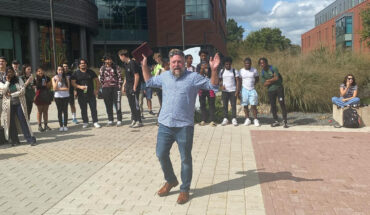WHY ARE HATE GROUPS TARGETING COLLEGES AND STUDENTS AND WHAT IS IN STORE FOR THE FUTURE?
By Michael Eberhart, News Editor
In the wake of last month’s violent “Unite the Right” rally at the University of Virginia (UVA), organizations including the Anti-Defamation League (ADL) and the Southern Poverty Law Center (SPLC) have updated warnings of racist hate groups active in colleges across the country.
The ADL called the rise in messaging and recruitment efforts by college hate groups “unprecedented,” involving over a hundred campuses in dozens of states.
The SPLC issued its guide to “The Alt-Right on Campus: What Students Need to Know” in the week leading up to the Charlottesville rally. The publication “examines the alt-right, profiles its key figures and… also recommend[s] ways to deconstruct and counter its propaganda.”
The organization also released an updated version of its guide, “Ten Ways to Fight Hate,” after the attack by a white supremacist left one anti-racist protester dead and 19 others injured. The new edition “advises readers on how to promote tolerance and effectively speak out against discrimination.”
“White nationalists really enjoy campus activism,” according to SPLC analyst Keegan Hankes. “They’re often trying to put an intellectual veneer on things, so it makes sense to peddle that on a college campus where you’re dealing with people who may be just starting to form their ideas about the world.”
Kevin Fornshill, an adjunct instructor with Mason’s Department of Criminology, Law and Society, matched this assessment.
“The white supremacist movement is growing older and to survive they need younger members,” Fornshill said in an interview with the Fourth Estate. “College students are traditionally very malleable and sort of finding their own way, so what better way to get a new population or new blood into the organization than to go to a college campus and speak to the needs and concerns of impressionable people?”
Fornshill explained that the white supremacist movement has undergone “a shift from the working class to move to the college campuses, and move to address the needs of race on a level that a college student would understand and would appreciate.”
“It’s repackaging the same ideology to a higher level of education,” he added.
Alt-right leaders like Richard Spencer and Nathan Damigo have proven Fornshill’s point in interviews with other publications.
Spencer, who graduated from UVA in 2001, told Mother Jones magazine in December that “People in college are at this point in their lives where they are actually open to alternative perspectives, for better and for worse…. I think you do need to get them while they are young.”
Speaking to the Boston Globe in March, Identity Europa founder Damigo said “These are people who will go on to manage the institutions of our country, and we want them in our networks.”
Anti-racist organizations reported a spike in racist literature and flyers from groups like Identity Europa have been found on college campuses in the last year. The SPLC recorded over 150 such incidents, and the ADL noted white supremacist materials found on 110 campuses in 34 states.
When asked if violence like Charlottesville was somehow unique to UVA or Virginia, Fornshill disagreed. “What happened in Charlottesville could have easily been transplanted to Raleigh-Durham, or Birmingham or it could have been anywhere,” he said.
Fornshill continued that members of the white supremacist movement feel that their heritage and ancestry are being threatened, so they need to stay active and continue to push their agenda.
“Unless good tactical planning is done on the part of law enforcement or local authorities,” Fornshill warned, “this could happen over and over again.”
Photo Courtesy of Michael Eberhart




